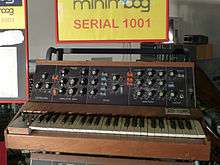Eboardmuseum
Founded in 1987 by the musician, mathematics teacher and engineer Gert Prix, the Eboardmuseum is a collection of electronic keyboard instruments. Very quickly it had outgrown the original venue. In 2007 the collection was moved into a hall at the fair area in the centre of Klagenfurt am Wörthersee in Austria. It is now considered to be the largest of its kind in Europe. In 2010 the Eboardmuseum was honored with the [1] seal of quality.
The Museum

In an area of about 1,700 m² the Eboardmuseum has about 1,500 exhibits.
Focusing on electronic keyboards the Eboardmuseum covers the entire history of these instruments from a 1935 Hammond model A to an up-to-date Moog Voyager.
Among the exhibits there are numerous preliminary models and unique items such as a Hohner Clavinet, Rhodes Piano, Mellotron as well as original instruments from international stars like Keith Emerson (Emerson, Lake & Palmer), Geoff Downes (Asia), Peter Wolf (Frank Zappa) and Tangerine Dream.
Unlike other musical instrument museums the Eboardmuseum does not only present its exhibits in guided tours, but also allows the visitors to play the instruments. Professionals and music enthusiasts from all around the world make use of this opportunity.
The Eboardmuseum library contains literature about electronic music, focusing on keyboards, pop music and pop culture.
Guided tours in the Eboardmuseum target everybody including non-musicians and children. They aim to offer an entertaining and family-friendly trip into the world of music.
Events
Live concerts are arranged weekly. The integrated event area in the Eboardmuseum is furnished with sofas, offering a living room experience. Here about 50 concerts per year take place. The previous and future programs are documented on the Eboardmuseum website.
Service Area
In open workshops visitors can watch the museum technicians at their work and have an insight into the inner workings of the instruments.
External links
References
Coordinates: 46°37′00″N 14°18′18″E / 46.6166°N 14.3050°E